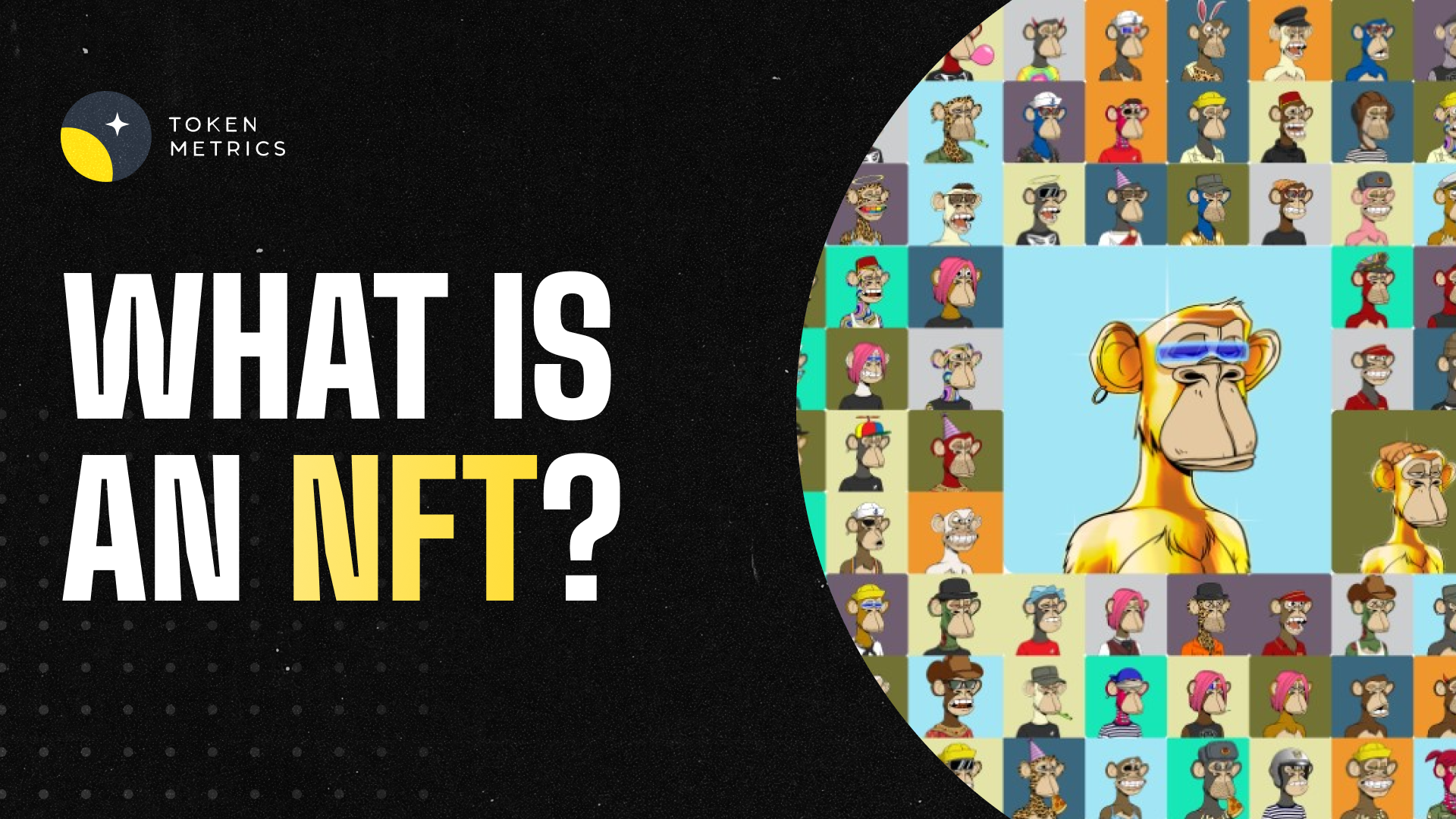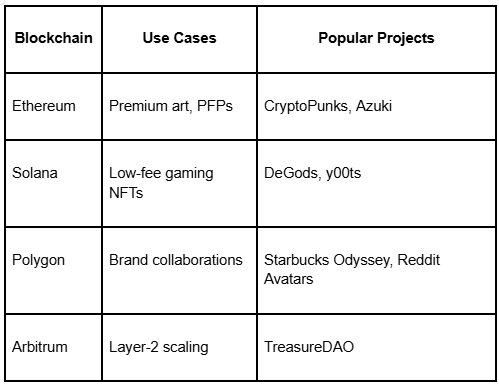
What Is an NFT? Complete Guide to Non-Fungible Tokens (2025)

Over the past few years, NFTs (Non-Fungible Tokens) have exploded in popularity—revolutionizing the way we think about digital ownership, art, gaming, collectibles, and more. In 2025, NFTs continue to shape the future of the internet, transforming everything from music rights to virtual real estate.
If you're wondering “What is an NFT?” or how they actually work, this guide breaks it down for you. We’ll also explore how AI-powered tools like Token Metrics can help you identify high-value NFT-related tokens and investment opportunities.
🔍 What Does NFT Stand For?
NFT stands for Non-Fungible Token. Let’s break that down:
- Token: A digital asset that exists on a blockchain.
- Non-Fungible: It’s unique and cannot be replaced with something else of equal value. (Unlike cryptocurrencies like Bitcoin, where each BTC is the same.)
So, an NFT is a unique digital asset stored on a blockchain, representing ownership of a specific item—like artwork, music, a tweet, a game character, or a piece of virtual land.
🎨 What Can Be an NFT?
NFTs aren’t just limited to pixelated apes or JPEGs. In 2025, NFTs power a broad range of digital assets:
- Digital Art: Artworks, animations, and generative art
- Collectibles: Rare items like trading cards or profile picture (PFP) projects
- Gaming Assets: In-game skins, weapons, characters, and land (e.g., in The Sandbox or Decentraland)
- Music and Media: Songs, albums, and exclusive content drops
- Virtual Real Estate: Land parcels in the metaverse
- Domain Names: Blockchain-based domain ownership
- Identity & Access: Membership passes, event tickets, or certification credentials
Each NFT has a unique identifier and metadata that distinguish it from any other asset.
🛠️ How Do NFTs Work?
NFTs are built and recorded on blockchains, most commonly on Ethereum using ERC-721 or ERC-1155 standards. Here’s how they work:
- Minting: Turning a digital file into a token on the blockchain
- Metadata: Storing details like title, creator, image URL, and traits
- Ownership: A smart contract verifies the wallet that owns the NFT
- Transferability: NFTs can be sold, traded, or gifted using marketplaces
Because of blockchain immutability, ownership is transparent, verifiable, and permanent.
📈 Why Are NFTs Valuable?
Several reasons explain the rising value and popularity of NFTs:
- Digital Ownership: You own the asset—not a platform
- Proven Scarcity: Many NFTs are limited in supply
- Creator Royalties: Artists earn fees on secondary sales
- Utility & Access: Some NFTs unlock real-world benefits, games, or private groups
- Social Status: PFPs like CryptoPunks or Bored Ape Yacht Club are digital status symbols
- Speculation: Many treat NFTs as investments, betting on future appreciation
In 2025, NFTs have gone beyond hype to form the foundation of Web3 identity and ownership.
💰 How to Buy an NFT
To buy an NFT, you’ll need:
- A crypto wallet (like MetaMask)
- Some ETH or other supported crypto for payment and gas fees
- An NFT marketplace like OpenSea, Blur, Magic Eden, or Rarible

Steps to Buy:
- Fund your wallet
- Connect to a marketplace
- Browse collections
- Click “Buy Now” or place a bid
- Approve the transaction
Once purchased, the NFT is transferred to your wallet and viewable on your profile.
⚠️ Are NFTs Safe?
NFTs are secure if you follow best practices. However, scams and phishing attacks are common.
Security Tips:
- Never share your seed phrase
- Verify contract addresses before minting
- Don’t connect your wallet to unknown sites
- Use hardware wallets for high-value NFTs
- Bookmark official sites
🧠 How Token Metrics Helps You Identify NFT-Related Investments
NFTs are not just collectibles—they’re tied to blockchain ecosystems and tokens. Platforms like Token Metrics help you identify high-potential NFT projects, gaming ecosystems, and utility tokens powering the space.
✅ How Token Metrics Helps:
- AI-powered Grades: See which NFT-related tokens are trending with Trader & Investor Grades
- Moonshots Tab: Find small-cap NFT tokens with 10x–100x potential
- Thematic Indices: Invest in curated NFT indices powered by Token Metrics AI
- Token Details Page: Dive deep into any NFT-related token’s fundamentals, holders, and performance
Whether it’s $IMX, $MAGIC, $APE, or a metaverse play like $MANA, Token Metrics gives you a data-driven edge.
🧩 Popular NFT Blockchains in 2025
NFTs are no longer limited to Ethereum. In 2025, several chains offer faster, cheaper minting and trading:

Token Metrics tracks all these chains, offering a cross-chain perspective for NFT investing.
🪙 What Are NFT Tokens?
Many NFT ecosystems have their own fungible tokens used for governance, staking, or ecosystem rewards. Examples include:
- $APE (Bored Ape Yacht Club)
- $MAGIC (TreasureDAO)
- $IMX (Immutable X)
- $LOOKS (LooksRare)
- $BLUR (Blur marketplace)
These tokens can rise in value based on NFT trading volume, user adoption, and staking incentives. Token Metrics’ analytics help traders spot breakout opportunities early.
🚀 Future of NFTs in 2025 and Beyond
NFTs are evolving fast. In 2025, they’re used for more than art and gaming:
- NFTs as IDs: Used for logging into apps and verifying reputation
- Real-world assets: Tokenizing real estate, music royalties, and legal contracts
- DeFi integrations: NFTs used as collateral in lending protocols
- Event access: NFTs as tickets for IRL and virtual experiences
- AI x NFTs: Generative AI tools minting and managing NFT metadata autonomously
Expect continued innovation, and stay ahead using tools like Token Metrics.
🧠 Final Thoughts: Are NFTs Worth It?
NFTs are more than a trend — they represent the digitization of ownership in the Web3 era. From art and identity to games and finance, NFTs unlock new possibilities for creators and collectors alike.
If you're looking to explore NFT opportunities beyond collectibles—Token Metrics gives you the data, AI tools, and insights you need to invest intelligently.

.svg)

Create Your Free Token Metrics Account

.png)




%201.svg)
%201.svg)


%201.svg)









.svg)




.png)